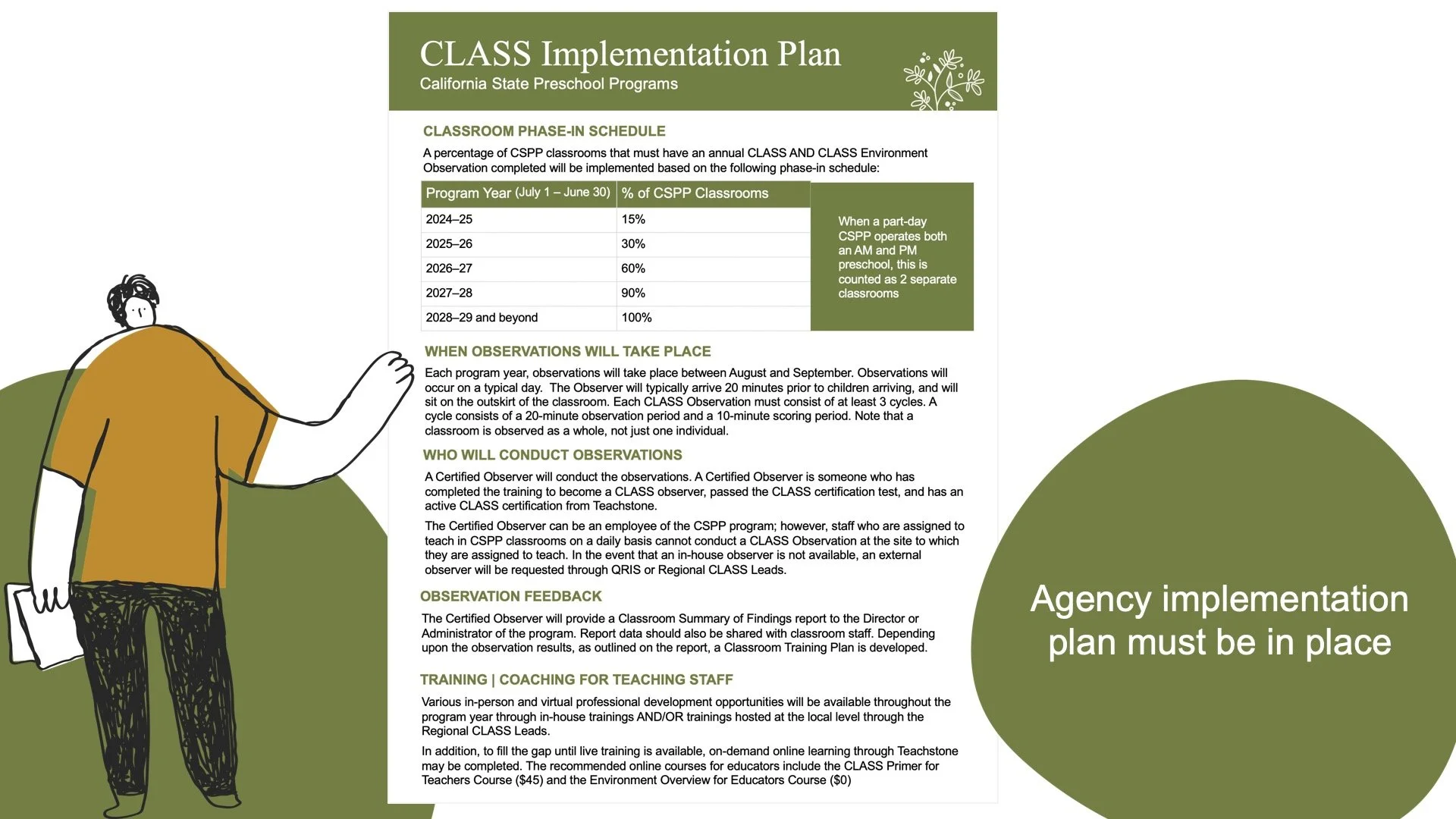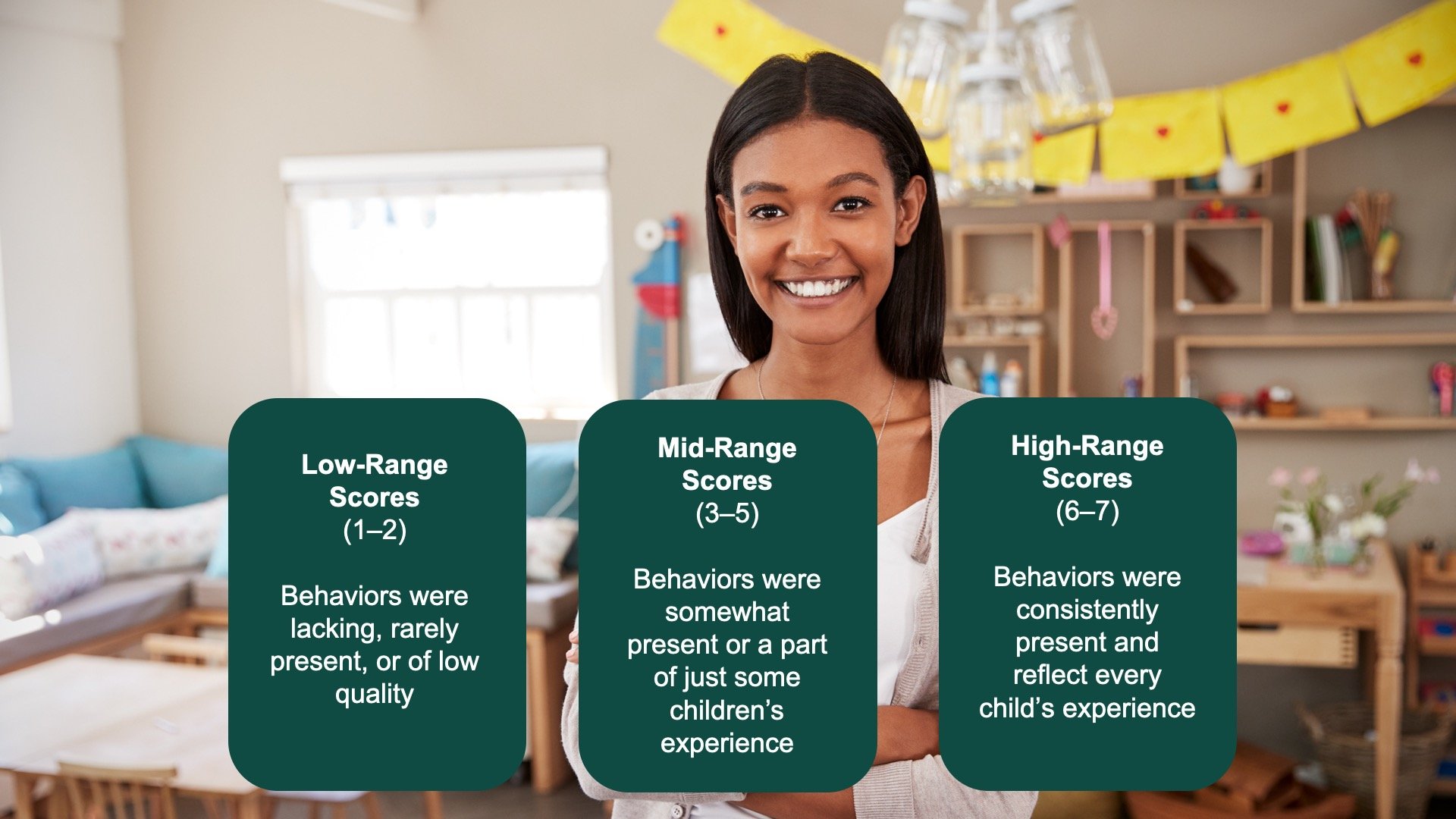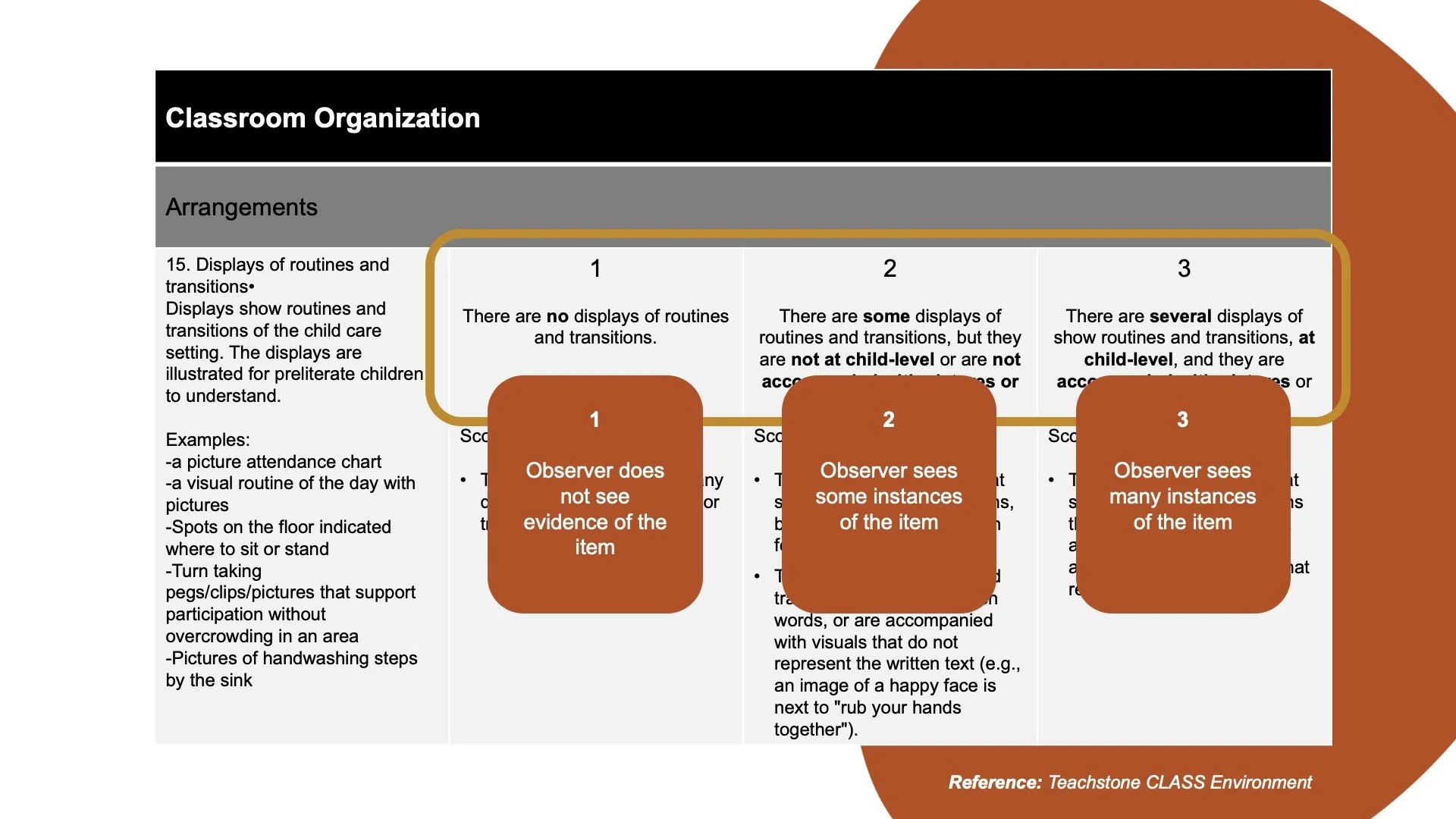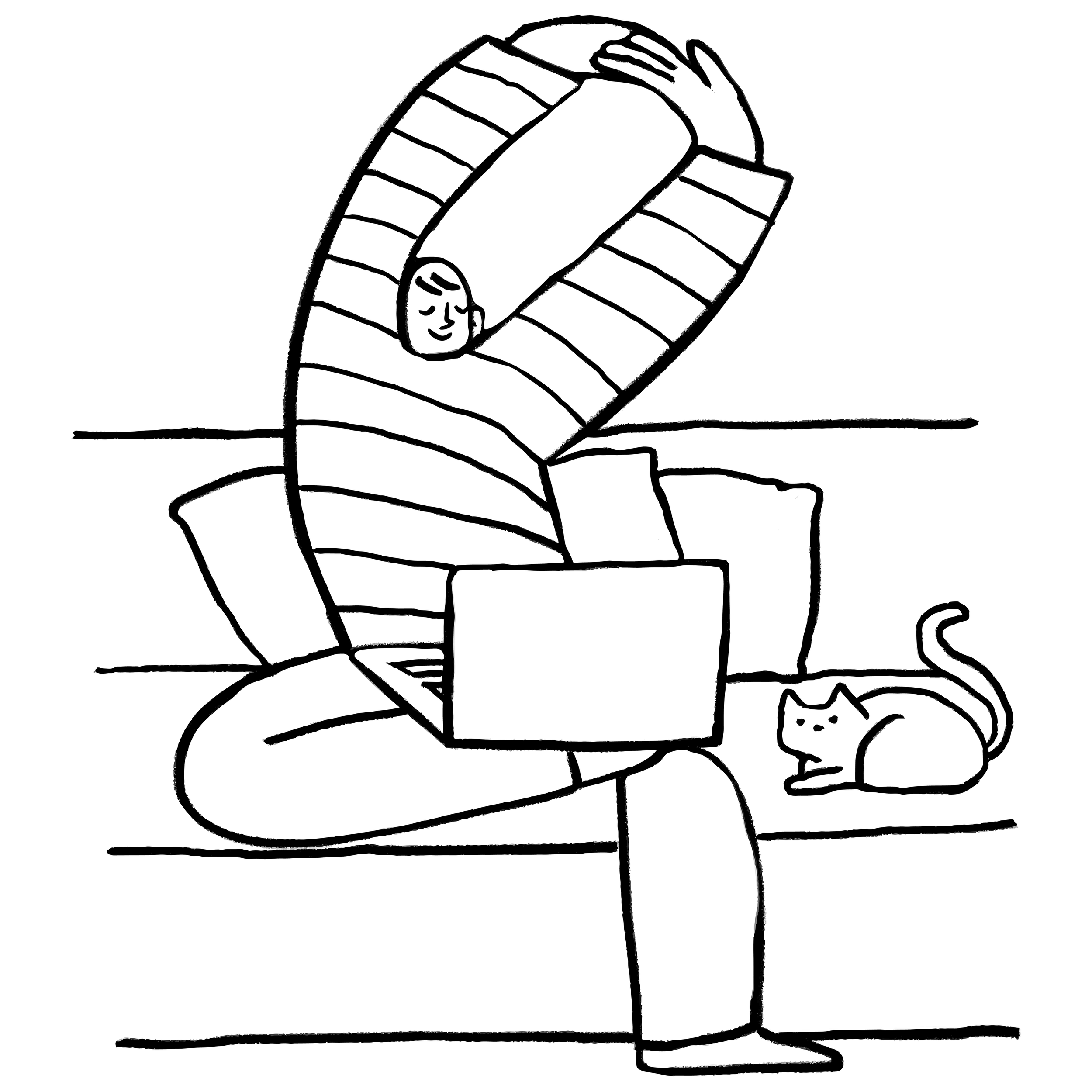Lesson 8
Classroom Assessment
Requirement
The California Department of Education has chosen specific classroom assessment system components for State Preschool programs that include the Classroom Assessment Scoring System (CLASS) 2nd edition, CLASS Environment tool, CLASS Support Series, and a few other additional quality components.
As indicated in Management Bulletin 23-10, for state preschool programs, the classroom assessment system must be implemented through a graduated phase-in approach beginning July 1, 2024, with full implementation in program year 2028–29.
Regulations/Reference
Watch Video Lesson ❯
EXTERNAL TRAINING NOTE:
Educator training/coaching opportunities for both CLASS and CLASS Environment may vary from one agency to another. For example training/coaching opportunities may include:
Regional Leads hosting trainings at a local level (in-person and/or virtual)
In-house training and coaching
Online learning through Teachstone. The following online courses are recommended for educators:
Sample Forms/Tools ❯
CLASS Resources
Environment Resources
Review Sketch Pad Notes ❯
CLASS
CLASS Implementation Plan
By October 1, 2024, all contractors must develop an agency plan for implementing CLASS and CLASS Environment and begin sharing with staff how the plan will roll-out.
The implementation plan must include when observations will take place, how classrooms will be phased-in, who will conduct observations, what training or coaching is available to teachers/staff, and how feedback will be provided back to the teaching staff in observed classrooms as part of the program’s continuous improvement.
NOTE: Talk with your program Director or Administrator regarding the specific CLASS implementation plan for your agency
CLASS Certified Observer
At the heart of CLASS are trained and certified observers. A certified CLASS observer means someone who has completed the training to become a CLASS observer, passed the CLASS certification test, and has an active CLASS certification from Teachstone.
In addition, the observer must be trained on CLASS Environment and the CLASS Observer Support Series.
An observer can be an employee of the State Preschool program; however, staff who are assigned to teach in state preschool classrooms on a daily basis cannot conduct a CLASS Observation at the site to which they are assigned to teach.
NOTE: In the event that an in-house observer is not available, an external observer will be requested through QRIS or Regional CLASS Leads.
What is CLASS (2nd edition)
Teachstone. Teachstone and the Power of Interactions [Video]. Embedded July 22, 2024
Through Teachstone, a contractor may access the Classroom Assessment Scoring System (CLASS), which is an observational instrument that captures the quality of the educator-child interactions in a classroom.
For preschool age children, CLASS assesses three DOMAINS of classroom experience:
Emotional Support
Classroom Organization
Instructional Support
Within each domain are DIMENSIONS that define the aspects of effective interactions in line with how kids learn and develop as they grow.
Each dimension has INDICATORS, which are the specific kind of behaviors that can be observed in classrooms.
NOTE: During a class assessment, the certified observer takes notes on observed interactions. The observer looks for certain behavioral markers and assigns scores for each dimension.
Observer will typically arrive 20 minutes prior to children arriving, and will sit on the outskirt of the classroom. Each CLASS Observation must consist of at least 3 cycles. A cycle consists of a 20-minute observation period and a 10-minute scoring period.
CLASS Scores
Certified CLASS observers use the CLASS tool to capture the quality of the educator-child interactions they see in a classroom. Note that the classroom is observed as a whole, not just one teacher. The observer looks for certain behavioral markers. They then assign scores across each dimension.
Low-range scores (1–2): Behaviors were lacking, rarely present, or of low quality
Mid-range scores (3–5): Behaviors were somewhat present or a part of just some children’s experience
High-range scores (6–7): Behaviors were consistently present and reflect every child’s experience
The Certified Observer will provide a Classroom Summary of Findings report to the Director or Administrator of the program. Report data should also be shared with classroom staff. Depending upon the observation results, as outlined on the report, a Classroom Training Plan is developed.
NOTE: CLASS data should be used by preschool programs to inform professional development, coaching, and other continuous quality improvement efforts. CLASS scores can NOT be used to evaluate staff competency.
Getting Observed
Teachstone. A Teacher’s Take on CLASS Observations [Video]. Embedded July 22, 2024
What to expect when a classroom is going to be assessed.
Observations typically take place between August and September
The classroom is observed as a whole, not just one individual
Observation should occur on a typical day, in order to get a good snapshot
Observer typically arrives 20 minutes prior to children arriving, and will sit on the outskirt of the classroom to observe in 20 minute increments
Typically an Observer will conduct both the CLASS and CLASS Environment Observations on the same day.
Be yourself | Trust in yourself | Take a deep breathe
CLASS Environment
What is CLASS Environment
CLASS focuses on interactions and CLASS Environment focuses on the elements in the learning setting that support meaningful interactions. By focusing on the features of the classroom (Arrangements | Displays | Materials) that most directly influence teaching and learning, CLASS Environment can support educators in designing settings to better support quality interactions.
CLASS Environment does not focus on the number of items, but instead focuses on whether specific items in the learning setting are present.
CLASS Environment is broken down by Emotional Support, Classroom Organization and Instructional Support. It is designed to measure environmental elements on a 3-point scale.
Observer does not see evidence of the item
Observer sees some instances of the item
Observer sees many instances of the item
NOTE: Observers can typically capture environmental quality data in under 15 minutes. The CLASS Environment observation is done in addition to the CLASS observation’s three cycles. Typically an Observer will conduct both the CLASS and CLASS Environment Observations on the same day.
CLASS Support Series
Snapshot of CLASS Support Series
To ensure California is centering diversity, equity, inclusion, and belonging, the Classroom Assessment System must also include supports for:
Children with Disabilities: During a CLASS observation, an observer will capture the ways educators adapt or modify materials so that children can fully engage with them, and adapt or modify activities so that children are able to contribute in meaningful ways.
Dual Language Learners: Observer will capture interactions or strategies used by educators to create a supportive environment for dual language learners.
NOTE: As part of an observers training, they must complete the CLASS Observation Support Series training designed to bring awareness and share strategies to reduce observers' biases during a CLASS observation.
Additional Quality Components
Snapshot of Additional Quality Components
State preschool contractors are also required to meet a few other additional quality components.
Provide children enrolled in Full-Day CSPP for over 4 hours with a regularly scheduled time to nap or rest. Furthermore, with regards to napping:
Cots or mats must be at least 18” apart.
Napping and rest activities must be provided in a clean and sanitary manner.
Space must be conducive to resting.
Schedule must provide a balance of structure and flexibility. The schedule must include the following each day:
A variety of play activities
Both fine and gross motor active play
At least one indoor and one outdoor play period (weather permitting)
Written hand washing procedures are posted in a place that is visible to children and adults. Handwashing procedures must be followed by children and adults.
Provide storage spaces with security provisions where staff can store their personal belongings.
Space and/or policies in place to support staff for work-related tasks such as conferences and meetings and to support staff for personal breaks.
Complete Knowledge Check ❯
After reviewing the video lesson & sketch pad notes, it’s time to check for understanding by completing a Knowledge Check. Note that Individual Knowledge Checks will conclude with a Certificate.









